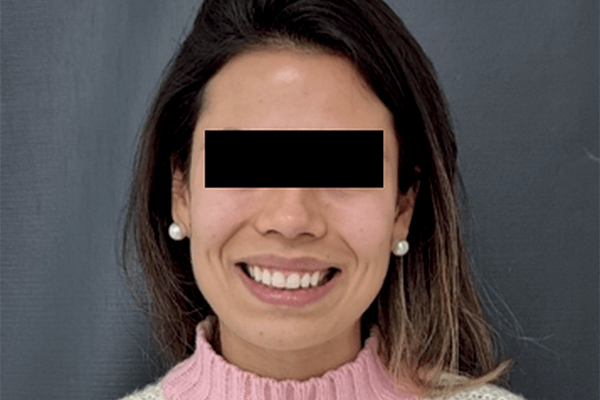RESUMO
A estética de um sorriso é um fator capaz de influenciar nas relações interpessoais, na expressão de sentimentos e na autoestima dos indivíduos. Nesse contexto, a exposição gengival excessiva, também conhecida como “sorriso gengival”, parece ser uma das principais características periodontais a afetar a estética. Dessa forma, o objetivo desse estudo foi relatar o caso clínico de uma paciente do sexo feminino com 31 anos, com queixa principal de sorriso gengival, detalhando possíveis condutas, técnicas cirúrgicas e manejo escolhido, além de discutir e destacar a vantagem da utilização do planejamento digital e de guias cirúrgicos em cirurgias de aumento de coroa clínica estético. Para resolução do caso, a técnica de aumento de coroa clínica estético foi escolhida por meio da incorporação de novas tecnologias, a fim de providenciar maior previsibilidade ao procedimento. Os resultados obtidos supriram as expectativas da paciente e seu sorriso passou a corresponder aos padrões estéticos desejados. A partir de um planejamento digital bem executado, análise de tomografia computadorizada de feixe cônico com afastamento de tecidos moles, escaneamento intraoral e do diálogo com a paciente, resultados altamente previsíveis, seguros e esteticamente naturais puderam ser alcançados.
Palavras-chave – Aumento da coroa clínica; Sorriso; Tomografia computadorizada de feixe cônico.
ABSTRACT
The aesthetics of a smile is a factor capable of influencing interpersonal relationships, the expression of feelings and self-esteem of individuals. In this context, excessive gingival exposure, also known as “gingival smile”, seems to be one of the main periodontal characteristics a ecting esthetics. Thus, the aim of this study was to report a clinical case of a female patient, 31 years old, with a chief complaint of gummy smile, detailing possible approaches, surgical techniques and the chosen management. As well as, discuss and highlight the advantage of using digital planning and surgical guides in aesthetic crown lengthening. To solve the case, the technique of lengthening of the esthetic clinical crown was chosen, through the incorporation of new technologies in order to provide greater predictability to the procedure. The results obtained met the patient’s expectations and her smile came to correspond to the desired aesthetic standards. From a well-executed digital planning, cone beam computed tomography analysis with soft tissue clearance, intraoral scanning and dialogue with the patient, highly predictable, safe and aesthetically natural results can be achieved.
Key words – Crown lengthening; Smiling; Cone beam computed tomography.
Referências
- Wagner TP, Costa RSA, Rios FS, Moura MS, Maltz M, Jardim JJ et al. Gingival recession and oral health-related quality of life: a population-based cross-sectional study in Brazil. Community Dent Oral Epidemiol 2016;44(4):390-9.
- Pavicic DK, Pavlic A, Devcic MK, Lajnert V, Spalj S. Tooth color as a predictor of oral health-related quality of life in young adults. J Prosthodont 2019;28(4):e886-92.
- Antoniazzi RP, Fischer LS, Balbinot CEA, Antoniazzi SP, Skupien JA. Impact of excessive gingival display on oral health-related quality of life in a Southern Brazilian young population. J Clin Periodontol 2017;44(10):996-1002.
- Koirala S. Smile makeup concept – creating beautiful, stylish and aromatic smiles. MiCD Journal 2019;1(1):6-10.
- Coachman C, Van Dooren E, Gürel G, Landsberg C, Calamita M, Bichacho N. Smile design: from digital treatment planning to clinical reality. Interdiscip Treat Planning 2012;2(2):119-74.
- Coachman C, Bohner L, Jreige CS, Sesma N, Calamita M. Interdisciplinary guided dentistry, digital quality control, and the “copy-paste” concepts. J Esthet Restor Dent 2021;33(7):982-91.
- Gargiulo AW, Wentz FM, Orban B. Mitotic activity of human oral epithelium exposed to 30 per cent hydrogen peroxide. Oral Surg Oral Med Oral Pathol 1961;14(4):474-92.
- Ingber JS, Rose LF, Coslet JG. The “biologic width” – a concept in periodontics and restorative dentistry. Alpha Omegan 1977;70(3):62-5.
- Schmidt JC, Sahrmann P, Weiger R, Schmidlin PR, Walter C. Biologic width dimensions – a systematic review. J Clin Periodontol 2013;40(5):493-504.
- Coachman C, Paravina RD. Digitally enhanced esthetic dentistry – from treatment planning to quality control. J Esthet Restor Dent 2016;28(suppl.1):S3-4.
- Chagas TF, de Almeida NV, Lisboa CO, Ferreira DMTP, Mattos CT, Mucha JN. Duration of effectiveness of Botulinum toxin type A in excessive gingival display: a systematic review and meta-analysis. Braz Oral Res 2018;32:e30.
- Zengiski ACS, Basso IB, Cavalcante-Leão BL, Stechman-Neto J, Santos RS, Guariza-Filho O et al. Effect and longevity of botulinum toxin in the treatment of gummy smile: a meta-analysis and meta-regression. Clin Oral Investig 2022;26(1):109-117.
- Vandenberghe B. The digital patient – imaging science in dentistry. J Dent 2018;74(suppl.1):S21-6.
- Guichet DL. Digital workflows in the management of the esthetically discriminating patient. Dent Clin North Am 2019;63(2):331-44.
- Zanatta FB, Giacomelli BR, Dotto PP, Fontanella VRC, Rösing CK. Comparison of different methods involved in the planning of clinical crown lengthening surgery. Braz Oral Res 2010;24(4):443-8.





